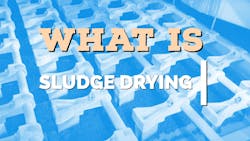What is sludge drying for wastewater treatment?
Key Highlights
- Sludge drying removes moisture via thermal energy, which decreases volume, reduces odor, and drops pathogen levels, making sludge safer and more manageable.
- Different drying methods include convective, conductive, and solar dryers, each with unique advantages and challenges related to cost, speed, and environmental impact.
- Thermal hydrolysis and biogas production can enhance drying efficiency and reduce energy consumption, supporting sustainable wastewater treatment practices.
- Dried sludge can be repurposed as biochar or manure, but its suitability depends on chemical properties like toxic metals and nutrient content.
What does drying sludge in wastewater treatment mean?
Drying sludge means to remove moisture, specifically water vapor from the sludge. This involves drying the sludge via evaporation using a source of thermal energy.
Sludge drying, sludge thickening, and sludge dewatering – what is the difference?
Sludge drying, as the literature points out, is not to be confused with sludge thickening and sludge dewatering which use mechanical processes to reduce the level of liquid water from the sludge. In some wastewater treatment plants, sludge drying is used after sludge dewatering.
Advantages of drying wastewater sludge
Drying sludge reduces the moisture content and therefore the volume of the sludge. Due to the reduced moisture, the population of pathogenic microorganisms and the odor are also reduced. The dried sludge is also less putrescent, i.e., less susceptible to decay because it contains less microorganisms.
With less moisture content, the concentration of calorific content of the sludge is increased. It makes the sludge suitable for thermochemical treatments including for incineration and pyrolysis.
How do you dry wastewater sludge?
A heat source is required to reduce the moisture content in the sludge. The heat source could be applied in an upstream anaerobic digester process or in a downstream thermochemical process.
What temperature does wastewater sludge dry at?
Thermal drying evaporates capillary water, surface water, and cellular water from the sludge. The temperature used in sludge drying varies depending on the method used. For belt dryers, the temperature range is 70oC to 150oC.
What methods can be used to dry sludge in wastewater treatment?
Different types of dryers can be used to dry sludge. The thermochemical processes in these dryers use the principles of convection, conduction, and radiation.
Convective dryers
Convective dryers, as in the name, involve the convection of hot air in a closed tunnel. The temperature ranges are lower than for conductive dryers. These dryers expose the wastewater sludge to hot air to evaporate the water. Examples include belt dryers, fluidized bed dryers, and rotary drum dryers.
Conductive dryers
Conductive dryers use heated surfaces that the sludge comes in contact with to evaporate the water. Disc dryers and thin film dryers are examples of conductive dryers.
Solar dryers
In solar dryers, the sludge is laid out to dry. Radiation is used to evaporate the water from the sludge. These dryers could be large greenhouses used by municipalities that has access to large spaces away from residential areas. While solar dryers could be less costly compared to the other dryers, controlling the air odor and slower drying time are some of the challenges for solar dryers.
A scholarly study compared the effects of thermal and solar drying on the content of the dried sludge. Thermal drying led to pellets with high lipid contents which the study suggested could be considered for fuel production.
The need for enhanced sludge drying
Dryers used in sludge drying can consume a substantial amount of energy for their operations depending on the type of sludge. The specific energy consumption for convective, conductive, and solar drying can range from 700 kilowatt hours per ton to 1400 kilowatt hours per ton.
Mixed and primary sludges require less evaporation than waste activated sludge to reach the same level of dryness because the latter has a higher amount of bound water due to the presence of biosolids. Biosolids require relatively more heat per ton of dry solids, and so more water evaporation to occur. Thermal hydrolysis and the use of biogas are processes to assist with the energy requirement to operate a dryer for sludge drying.
Thermal hydrolysis and biogas for enhanced sludge drying in wastewater systems
Thermal hydrolysis improves the breakdown of sludge and thus can improve the efficiency of sludge drying. In the thermal hydrolysis process, the sludge is exposed to high temperature and pressure. It removes volatile solids and reduces the amount of sludge or organic material to dewater. Treating the sludge with thermal hydrolysis prior to the use of dryers for drying the sludge reduces the energy demands for the dryers. Also, the biogas produced in the thermal hydrolysis process can be used to power sludge dryers.
Other processes including vacuum assisted thermal drying can be used for sludge drying. This process is affected by the surface area of the sludge.
Can dry sludge or biosolids be used as manure?
Besides reducing the concentration of microorganisms, sludge drying reduces the weight and the volume of the sludge making it easier to transport and dispose the treated sludge. The dried sludge can also be used as biochar and manure.
Sewage sludge may contain antibiotic-resistant bacteria and a scholarly study mentioned that sludge treatment processes including drying may control the level of these bacteria and their adverse effects when the dried sludge is used as manure.
However, the application of dried sludge as manure depends on its chemical properties. A scholarly study mentioned that the pH, humus content, and the chemical composition, namely toxic metal elements, organic content, and the concentrations of nitrogen and phosphorus, can affect the dried-sludge amended soil.
Take-away points
- Sludge drying is an integral process in wastewater treatment to remove water vapor from the sludge using thermal energy. It is different than sludge thickening and sludge dewatering.
- Because the thermal dryers require high energy consumption to dry the sludge, the use of thermal hydrolysis and biogas can improve the cost-effectiveness of sludge drying.
- Although sludge drying can reduce the levels of microorganisms and control the levels of antibiotic-resistant bacteria, the application of dried sludge as manure can affect the soil depending on the chemical properties of the dried sludge including its toxic metal contents.
Take a quiz on sludge drying for wastewater treatment
About the Author
Saleha Kuzniewski
Saleha Kuzniewski, Ph.D. has authored several publications in the fields of scientific research, biotechnology, and environmental regulations. She is the winner of the 2023 Apex award for publication excellence. She is also the founder of Environmental Remediation & Innovations, LLC. Kuzniewski can be reached at [email protected].

